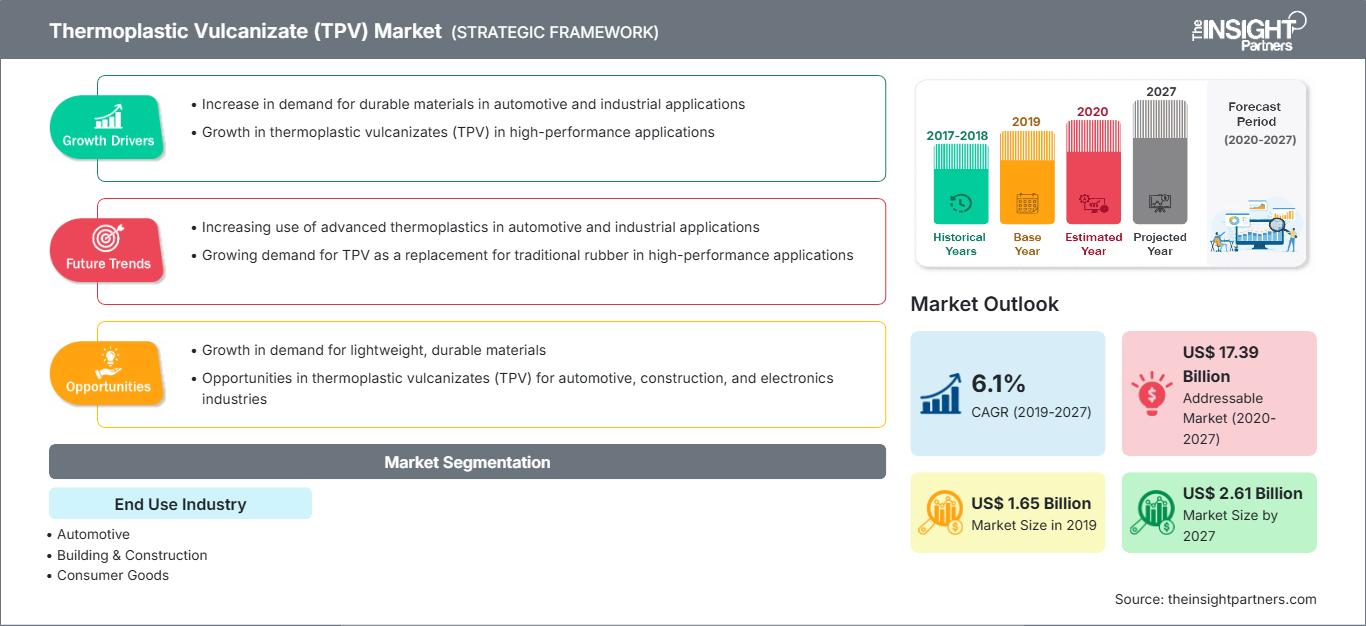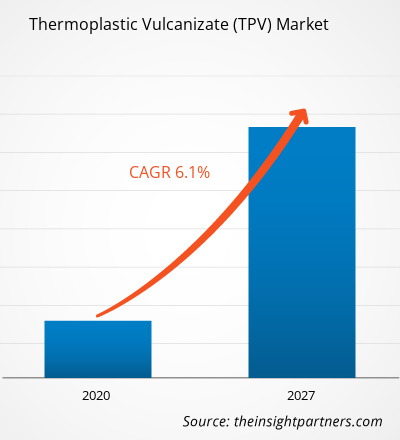2019 年热塑性硫化橡胶 (TPV) 市场价值为 16.4678 亿美元,预计到 2027 年将达到 26.125 亿美元;预计预测期内的复合年增长率为 6.1%。
热塑性硫化橡胶广泛应用于洗衣机和烘干机、洗碗机、小家电、手柄和密封件以及冰箱等各种产品中,用作刚性部件和密封件。由于热塑性硫化橡胶在服装、家用电器、个人护理产品、厨具和电动工具等不同应用领域具有轻质、多功能和柔软等优势,预计消费品行业对热塑性硫化橡胶的需求将会增加。此外,金砖四国消费品行业的增长也有望对热塑性硫化橡胶市场产生积极影响。热塑性硫化橡胶 (TPV) 具有卓越的效率、更低的系统成本和潜在的可持续性。凭借这些优势,TPV 广泛应用于消费品行业。例如,埃克森美孚化工生产的热塑性硫化橡胶 (TPV) 采用高性能弹性体,具有生产灵活性、易于加工和耐用性等特点。TPV 可在工业和高要求的消费应用中提供卓越且稳定的性能,与 EPDM(三元乙丙橡胶)或其他热固性橡胶相比,它具有降低设备成本、减轻重量和可回收利用的潜力。
预计在预测期内,北美将占据全球热塑性硫化橡胶 (TPV) 市场的最大份额。许多国内外公司在北美地区都拥有稳固的立足点。该地区热塑性硫化橡胶 (TPV) 市场的增长主要归因于生产多种汽车零部件对轻质材料的需求不断增长。此外,预计在预测期内,政府出台了有利于TPV在汽车应用中作为合金和金属替代品的消费的法规,以及美国和墨西哥乘用车产量的增加,将进一步推动区域市场的增长。此外,技术发展和对电动汽车日益增长的需求也增加了对轻质、坚固和可回收产品的需求,这反过来又推动了市场的增长。截至2020年12月,就确诊病例和报告死亡人数而言,美国、印度、巴西、俄罗斯、法国、英国、土耳其、意大利和西班牙是受影响最严重的国家之一。根据世界卫生组织截至2020年12月的数据,全球已报告确诊病例约80,453,105例,死亡病例1,775,776例。由于封锁、旅行禁令和企业倒闭,COVID-19疫情对各经济体造成了影响。全球化学品和材料行业是受这些限制导致供应链断裂和生产中断的主要行业之一。中国是全球制造业中心,也是各行各业最大的原材料供应国。亚太地区和欧洲等主要地区多家工厂的停工停产,正在影响全球供应链,并对生产制造、交货进度和产品销售产生负面影响。这些因素对全球热塑性硫化橡胶 (TPV) 市场的增长产生了不利影响。
自定义此报告以满足您的要求
您将免费获得任何报告的定制,包括本报告的部分内容,或国家级分析、Excel 数据包,以及为初创企业和大学提供超值优惠和折扣
热塑性硫化橡胶(TPV)市场: 战略洞察

-
获取本报告的主要市场趋势。这个免费样本将包括数据分析,从市场趋势到估计和预测。
为了减少对石油等不可再生资源的依赖,实现高分子材料行业的可持续发展,生物基高分子材料受到广泛青睐。生物基热塑性硫化橡胶(TPV)由聚乳酸(PLA)和乙烯-醋酸乙烯酯橡胶(EVA)组成,以过氧化二异丙苯(DCP)为固化剂;这是PLA在弹性材料中的应用首次得到证实。由于生物基TPV碳排放低且本质上可生物降解,因此大多数国家都鼓励合成生物基TPV。它们目前被认为是传统石油基聚合物的可持续替代品,因为它们来源于可再生资源,例如淀粉基聚合物、聚乳酸(PLA)、聚羟基烷酸酯(PHA)、纤维素基聚合物和大豆基聚合物。生物基TPE不仅提供了清洁的解决方案,而且还为生物基TPE生产商提供了相对于合成TPE的成本竞争力,因此预计将创造巨大的市场增长机会。
最终用途行业洞察
根据最终用途行业,热塑性硫化橡胶 (TPV) 材料市场细分为汽车、建筑、消费品、医疗保健等。2019年,汽车领域占据了市场主导地位。由于对豪华、低排放、安全和高性能汽车的需求不断增长,汽车轻量化材料在过去几年中经历了强劲增长。因此,供应商和制造商推出了许多解决方案,不仅可以帮助原始设备制造商 (OEM) 遵守严格的法规,还可以满足日益增长的个人客户需求。TPV也是昂贵弹性体的合理替代品。它们具有优异的弹性体耐久性,包括相对较高的拉伸强度和断裂伸长率、高弹性回复率以及在热空气中良好的尺寸稳定性,以及优异的耐紫外线老化、臭氧和风化性能。TVP 在汽车行业的主要应用包括软管套、进气管套、垫圈、密封件、波纹管套、减震器、支柱盖、点火部件、衬套和车窗密封条。柔性 TPV 汽车引擎盖下部件包括进气管和波纹管、车轮的喇叭口、转向系统的波纹管以及消音部件。此外,TPV 的成本比 EPDM 低 10% 至 30%,而且重量更轻,设计灵活性更高,并且可回收利用。
三井化学公司、塞拉尼斯公司、三菱化学公司、锦湖聚合化学公司、盛禧奥公司、Teknor Apex、埃克森美孚公司、日本瑞翁化学公司、Alphagary 和 Ravago 是全球热塑性硫化橡胶 (TPV) 市场的主要参与者。这些公司正在实施新产品开发和并购战略,以扩大各自的客户群,并在全球市场上获得显著的市场份额,从而维护自己的品牌名称。
报告重点
- 全球热塑性硫化橡胶 (TPV) 市场不断发展的行业趋势,有助于参与者制定有效的长期战略
- 发达市场和发展中市场采用的业务增长战略
- 2017 年至 2027 年全球热塑性硫化橡胶 (TPV) 市场的定量分析
- 各行业全球热塑性硫化橡胶 (TPV) 需求估计
- PEST 分析,以说明行业内买家和供应商的效力
- 了解竞争激烈的市场形势和全球热塑性硫化橡胶 (TPV) 需求的最新发展
- 市场趋势和展望,以及推动和抑制全球热塑性硫化橡胶 (TPV) 增长的因素市场
- 了解支撑市场增长的商业利益的策略
- 全球热塑性硫化橡胶 (TPV) 市场在各个市场节点的规模
- 市场的详细概述和细分,以及其行业动态
- 全球热塑性硫化橡胶 (TPV) 市场在各个地区的规模以及各自地区的良好增长机会
热塑性硫化橡胶(TPV)市场区域洞察
The Insight Partners 的分析师已详尽阐述了预测期内影响热塑性硫化橡胶 (TPV) 市场的区域趋势和因素。本节还探讨了北美、欧洲、亚太地区、中东和非洲以及南美和中美洲的热塑性硫化橡胶 (TPV) 市场细分和地域分布。
热塑性硫化橡胶(TPV)市场报告范围
| 报告属性 | 细节 |
|---|---|
| 市场规模 2019 | US$ 1.65 Billion |
| 市场规模 2027 | US$ 2.61 Billion |
| 全球复合年增长率 (2019 - 2027) | 6.1% |
| 历史数据 | 2017-2018 |
| 预测期 | 2020-2027 |
| 涵盖的领域 |
By 最终用途行业
|
| 覆盖地区和国家 |
北美
|
| 市场领导者和主要公司简介 |
|
热塑性硫化橡胶 (TPV) 市场参与者密度:了解其对业务动态的影响
热塑性硫化橡胶 (TPV) 市场正在快速增长,这得益于终端用户需求的不断增长,而这些需求的驱动因素包括消费者偏好的不断变化、技术进步以及对产品优势的认知度不断提高。随着需求的增长,企业正在扩展产品线,不断创新以满足消费者需求,并抓住新兴趋势,从而进一步推动市场增长。

- 获取 热塑性硫化橡胶(TPV)市场 主要参与者概述
- 汽车
- 建筑与施工
- 消费品
- 医疗保健
- 其他
公司简介
- 三井化学公司
- 塞拉尼斯公司
- 三菱化学公司
- 锦湖聚合化学公司
- 盛禧奥公司
- Teknor Apex公司
- 埃克森美孚公司
- 日本瑞翁化学公司
- Alphagary公司
- Ravago公司
- 历史分析(2 年)、基准年、预测(7 年)及复合年增长率
- PEST和SWOT分析
- 市场规模、价值/数量 - 全球、区域、国家
- 行业和竞争格局
- Excel 数据集
近期报告
客户评价
购买理由
- 明智的决策
- 了解市场动态
- 竞争分析
- 客户洞察
- 市场预测
- 风险规避
- 战略规划
- 投资论证
- 识别新兴市场
- 优化营销策略
- 提升运营效率
- 顺应监管趋势






















 获取免费样品 - 热塑性硫化橡胶(TPV)市场
获取免费样品 - 热塑性硫化橡胶(TPV)市场